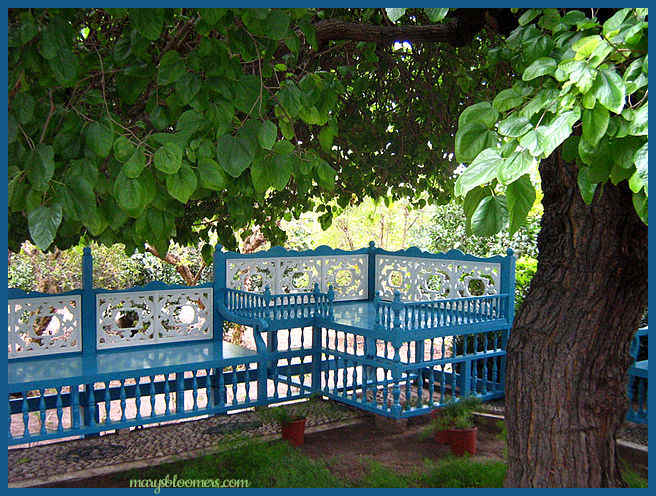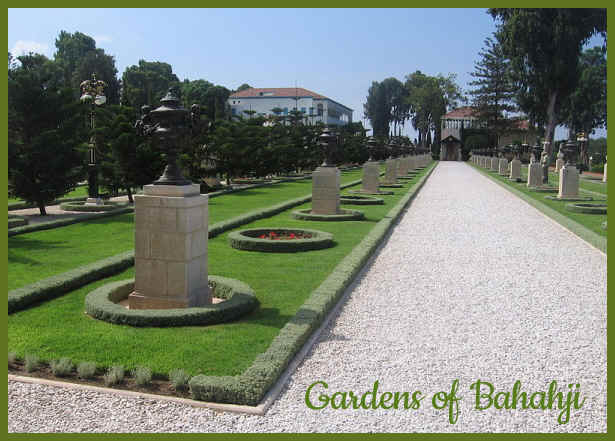The Baháʼí
The principal Bahāʾī
tenets are the essential unity of all religions and the unity of
humanity. Bahāʾī's believe that all the founders of the
world’s great religions have been manifestations of God and agents of
a progressive divine plan for the education of the human race. Despite
their apparent differences, the world’s great religions, according to
the Bahāʾīs, teach an identical truth. Bahāʾī's
believe in the oneness of humanity, and devote themselves to the
abolition of racial, class, and religious prejudices. The great bulk of
Bahāʾī teachings is concerned with social ethics. The
faith has followers all over the world. There are seven million Baha’i
in the world, about 150,000 in the United States. Adherents are still
subject to severe persecution in Iran and some other countries.
We can utilize this principle in our
own gardens, by planting a large variety of plants alongside each other.
I would have it no other way! A garden with diversity will be better
able to withstand the disease in one plant. Another benefit is that
plants flower at different times of the year. A garden with diversity
will always have some plants flowering.
"The excellency, the adornment
and the perfection of the earth is to be verdant and fertile through the
bounty of the clouds of springtime. Plants grow; flowers and fragrant
herbs spring up; fruit-bearing trees become full of blossoms and bring
forth fresh and new fruit. Gardens become beautiful, and meadows
adorned; mountains and plains are clad in a green robe, and gardens,
fields, villages and cities are decorated."
Another common theme in the Bahá'í
writings is the importance of the gardener, symbolizing the Divine
Educator. "If the earth is not cultivated, it becomes a jungle
where useless weeds grow; but if a cultivator comes and tills the
ground, it produces crops which nourish living creatures. It is evident,
therefore, that the soil needs the cultivation of the farmer. Consider
the trees: if they remain without a cultivator, they will be fruitless,
and without fruit they are useless; but if they receive the care of a
gardener, these same barren trees become fruitful, and through
cultivation, fertilization and engrafting the trees which had bitter
fruits yield sweet fruits...."
Trees exemplify the diversity of
humanity. "This diversity of type is apparent throughout the whole
of nature.... Let us look... at the beauty in diversity, the beauty of
harmony, and learn a lesson from the vegetable creation. If you behold a
garden in which all the plants were the same as to form, color and
perfume, it would not seem beautiful to you at all, but, rather,
monotonous and dull. The garden which is pleasing to the eye and which
makes the heart glad, is the garden in which are growing side by side
flowers of every hue, form and perfume, and the joyous contrast of
colour is what makes for charm and beauty."A dimension of the Bahá'í
is the important direct link between nature and spirituality, with
Divine qualities reflected through the creation.
The Bahá'í approach links the
preservation and reclamation of the earth's resources with both the
protection of the physical world and the heritage of future generations.
It has encouraged the essentially humanitarian work of such
groups as the Men of the Trees and the World Forestry Charter, and their
noble objective of reclaiming the desert areas of Africa.
History of Baháʼí gardens
in Israel
Baháʼí
gardens can be found at Baháʼí Holy Places in Israel and
elsewhere, and at Baháʼí Houses of Worship. Many Baháʼí
holy places in Haifa and around Acre, Israel, were inscribed on the
World Heritage List.
There are more
than 450 different varieties of plants and flowers on the grounds
maintained by 160 garden department irrigation technicians, tree care
specialists, horticulturists and pest management team members in Haifa,
alone. Garden maintenance teams spend 10 hours a day, five days a week
gardening and weeding.
Flowers also play an important role.
Roses have deep symbolic meaning. The founder of the Bahá’í faith,
mentions roses in his writing more than any other flower. They are often
used as a metaphor to explain important Bahá’í teachings, like unity
in diversity, the love of God, and the spiritual health of an individual
in their community. Other flowers were chosen for their appearance in
scripture, their beauty, fragrance, or vibrant colors.
Some ideas
for designing a Baháʼí Garden, besides
roses of all types:
Ornamental Oregano, Thyme,
Hydrangeas, zinnias, calla lilies, snapdragons, starflowers, Trailing
Rosemary, native North American plants (coneflowers, anise hyssop, swamp
milkweed, bee balm, and little bluestem), tulips, flowering cherry,
crabapple, hardy palms, cypress, Jacaranda tree.
Persian Influence is commonly seen,
and many of the historic gardens have this element. You can find
ornamental garden objects that would fit in well with the opulent Taj
Mahal feel.
Many of
these common garden elements can be traced to the Persian Garden
influences.
-
The
origin of Persian gardens may date back as far as 4000 BCE; the
presence of water grew increasingly important. Great emphasis placed
on fountains and ponds in gardens.
-
Sunlight
and its effects were an important factor of structural design in
Persian gardens. Textures and shapes were specifically chosen by
architects to harness the light.
-
Shade
is also very important in the garden. Trees and trellises are used
to create resting areas for gathering and seclusion that are
especially needed in the Persian summer heat.
-
The
Persian style often attempts to integrate that which is
“indoors” with the “outdoors”. This is often achieved
through the connection of a surrounding garden, with an inner
courtyard.
The Faith
Baha'i is a monotheistic faith. It
is similar to other religions in its messianic teachings and the faith
adheres to the belief that all messiahs of the major religions i.e.
Buddha, Jesus, Mohammed, etc., are messengers bearing guidelines for
individual holy destinies. The faith was founded in
nineteenth century Persia.
The faith has no priesthood and does
not observe ritual forms in its worship. A primary
theme is education. Achieving world peace through the establishment of
unity, justice and equality. Therefore, teachings specifically advocate
for racial unity, gender equality, universal education, and harmony of
science and religion. There are no initiation ceremonies, no sacraments,
and no clergy.
Every Bahāʾī,
however, is under the spiritual obligation to pray daily; to abstain
totally from narcotics, alcohol, or any other substances that affect the
mind; to practice monogamy; to obtain the consent of parents to
marriage; and to attend the Nineteen Day Feast on the first day of each
month of the Bahāʾī calendar. If capable, those between
the ages of 15 and 70 are required to fast 19 days a year, going without
food or drink from sunrise to sunset. The feasts are designed to ensure
universal participation in the affairs of the community and the
cultivation of the spirit of brotherhood and fellowship.
Interestingly,
considering the number of temples and gardens of the faith, there are
750 Baha'i volunteers from 70 countries in Haifa and Acre.
All of them come for limited stays, and none stay permanently.
Therefore,, there is no resident Baha'i community in Israel.
Well-Known
Bahá iʼGardens
Gardens
of Bahahji
Bahá’í
Gardens in ‘Akko
"Place
of Delight"
The
gardens at Bahjí in ‘Akko form a wide circle surrounding the historic
mansion where Bahá’u’lláh, the Prophet-Founder of the Bahá’í
Faith, resided during the final years of His life and the shrine where his
remains were laid to rest.
The
approach to the circular garden is a long, straight path framed with
cypress trees and informal plantings. It is a wall-less sanctuary that is
protected without being enclosed.
The
Mansion of Bahjí (meaning “Place of Delight”) was built in 1821 by
‘Abdu’lláh Páshá, then the Turkish governor of Acre. Bahá’u’lláh
occupied the mansion from 1879 until His passing in 1892. He is buried in
a small building adjacent to the Mansion known as the Shrine of Bahá’u’lláh.
Over the years, this Holy Place has been beautified with formal gardens
extending in a large circle around the Shrine. Here the formal, precise
gardening flows around historic buildings and natural elements that
include a centuries-old sycamore fig tree and the remains of an ancient
olive grove.
Beautified with paradise gardens,
which are called Haram-i-Aqdas (the Most Holy Precincts or
Sanctuary) and are intersected by a circular path. The Mansion, shrine,
and surrounding gardens are among the most sacred spots on earth for Baháí's,
and are Baháʼí pilgrimage sites.
The Shrine of Baháʼu'lláh is
composed of a central area that contains a small, tree-filled garden
surrounded by paths covered with Persian rugs. A glass roof was
constructed by Qulám-ʻAlíy-i-Najjár after the death of Baháʼu'lláh.
At the northwest corner of the central area there is a small room
where Baháʼu'lláh's remains are laid to rest.
|

|
|
Gardens
near the Shrine in Acre, Israel |
|
The Shrine of
the Báb and its terraces on Mount Carmel, Haifa, Israel |
The
Terraces of the Baháʼí Faith, also known as the Hanging Gardens
of Haifa, are garden terraces around the Shrine of the Báb on Mount
Carmel in Haifa, Israel. The gardens rest in the neighborhoods of Wadi
Nisnas and Hadar HaCarmel. They are one of the most visited tourist
attractions in Israel. Along with the Baháʼí Holy Places in Western
Galilee, it is a UNESCO World Heritage Site. The terraces represent the
first eighteen disciples of the Báb, who were designated "Letters of
the Living".
Nine
concentric circles provide the main geometry of the eighteen terraces.
Just as the identification of a circle presupposes a center, the terraces
have been conceived as generated from the Shrine of the Báb. The eighteen
terraces plus the one terrace of the Shrine of the Báb make nineteen
terraces total. Nineteen is a significant number within both the Baháʼí
and Bábí religions. 19 is the symbol of
unity and had significant meaning.
The gardens are linked by
a set of stairs flanked by twin streams of running water cascading down
the mountainside through the steps and terrace bridges. The
gardens have elements of the Persian paradise gardens, isolating the site
from the noise of the surroundings and connecting the different Baháʼí
buildings on Mount Carmel together.
Ecology
- The irrigation system includes a computer which, based on meteorologic
data it receives, controls hundreds of valves to distribute water
throughout the gardens by sprinkling and dripping. This is done at night
and in the early morning, to avoid wasting water by evaporation. The water
that flows alongside the stairs is circulating in a closed system within
each terrace, so that little water is wasted.
Arc
and Monument Gardens
|
The Arc gardens
at the Bahá'í World Center in Haifa, Israel |
The Monument Gardens, set
within the Arc gardens at the Baháʼí World Center on Mount Carmel,
are a set of gardens which hold the graves of some of the members of the
Baháʼí holy family.
Garden
of Ridván, Akka
 |
|
The
Garden of Ridván (garden of paradise) |
The Garden of Ridván
is a Baháʼí holy place situated just outside Acre.
Originally known as the 'garden of Naʻmayn', it was rented by
ʻAbdu'l-Bahá (Baháʼu'lláh's son) for Baháʼu'lláh where
he enjoyed spending the later part of his life, after years in a desolate
prison cell.
During the 1930s and 1940s the island setting of the garden disappeared,
as a result of a draining project against malaria. In 2010 a three-year
restoration and conservation project of the garden and the original water
canals surrounding it was completed, after which the Ridvan Garden became
an island once again.
At
Baháʼí Houses of Worship - All Baháʼí
temples are surrounded by gardens.
The Baha'i House of Worship,
Wilmette, IL.
Sources
Britannica
Wikipedia
Bahaipedia
Wikimedia Commons
Bahá'í writings
International Environment Forum
|








